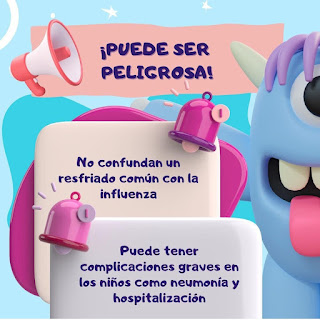La Influenza y el Resfriado Común
Influenza and the Common Cold
EDITORIAL ESPAÑOL
==================
Lo primero que debes entender a través de este Post, es que la
INFLUENZA y EL RESFRIADO COMÚN, o simple resfriado tienen diferencias que debes conocer para
tomar las medidas adecuadas en cada caso:
El Resfriado común: es causado por los Rinovirus,
Virus de la parainfluenza y Coronavirus estacionales.
La Influenza: es causada por el Virus de la
Influenza, existen 4 tipos: A, B, C y D. Los virus A y B son los responsables de las
epidemias estacionales de gripe en las personas.
Ambas enfermedades son contagiosas pero su comportamiento y
síntomas en el cuerpo varían, aun siendo algunos de ellos
los mismos.
El resfriado común, suele durar entre 10 días y 2
semanas como máximo, la Influenza puede durar
más de 2 semanas.
El malestar general, fiebre y la tos son
más intensos en la Influenza que en el
Resfriado
Común, otros síntomas compartidos son dolores
musculares, escalofríos, moqueo, congestión nasal,
y dolor de cabeza.
Los estornudos y dolor de garganta son
más intensos en el Resfriado Común que en
la Influenza.
Como podrás observar los síntomas son
similares, pero
en la Influenza, la evolución puede ser
tórpida sin un buen tratamiento, obligando a la
hospitalización que en algunos casos puede
complicarse con neumonía.
El resfriado común por lo general
se resuelve en el tiempo estipulado sin
grandes complicaciones, pero repitiendo, hay que
estar vigilantes ante cualquier signo de
deterioro, deshidratación, vómitos, etc, para evitar males
mayores.
Nota: la O.M.S y la O.P.S. declararon
el 6 de Junio 2023 una
alerta epidemiológica por el
Virus Sincitial Respiratorio (V.S.R)
y Sars- Cov-2.
De Modo que para evitar estas virosis
las mismas Autoridades
Sanitarias recomiendan la
Vacunación adecuada de los
niños.
The first thing you should understand
through this Post is that
INFLUENZA and THE COMMON COLD,
or simple cold, have differences that
you should know to take the
appropriate measures in each
case:
The common cold: is caused by
seasonal rhinoviruses, parainfluenza
viruses and coronaviruses.
Influenza: it is caused by the
Influenza Virus, there are 4 types: A,
B, C and D. Viruses A and B are
responsible for seasonal flu epidemics
in people.
Both diseases are contagious but
their behavior and symptoms in the
body vary, even though some of them
are the same.
The common cold usually lasts
between 10 days and 2 weeks maximum,
the Influenza can last more than 2
weeks.
General malaise, fever and
cough are more intense in the flu than
in the cold.
Common, other shared symptoms are
muscle aches, chills, runny nose,
nasal congestion, and headache.
Sneezing and sore throat are
more intense in the Common Cold than
in the Influenza.
As you can see, the symptoms are
similar,
but in Influenza, the evolution can
be torpid without good treatment, requiring hospitalization, which in
some cases can be complicated by
pneumonia.
The common cold usually
resolves within the stipulated time
without major complications, but
again, we must be vigilant for any
signs of deterioration, dehydration,
vomiting, etc., to avoid greater
illnesses.
Note: the W.H.O. and the P.O.S. On
June 6, 2023, they declared an
epidemiological alert for the
Respiratory Syncytial Virus (RSV)
and Sars-Cov-2.
So, to avoid these viruses, the same
Health Authorities recommend adequate
Vaccination of children.



















